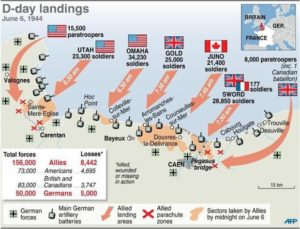D-Day is military shorthand for the first day of a military operation. The jargon also includes H-Hour, which refers to the first hour of the operation. These codes provide additional secrecy and allow enhanced planning. By combining the letters with positive or negative numbers planners can specify exact times for actions to take place. For example, H-2 means two hours before the start and D+1 signifies one day after D-Day.
The most well-known D-Day is 6 June 1944, the first day of the allied invasion of France. Many people mistake D-Day as the code name for the invasion. The actual code name for the overall invasion was Operation Overlord, while the landings were known as Operation Neptune. The invasion remains the largest seaborne invasion in history. Eleven months and one day later (D+336) General Alfred Jodl signed the unconditional surrender of all Nazi forces ending the war in Europe.
While some, especially in Russia, argue that the Soviet forces would have won the war without the allied invasion; we can all agree that world would have been much different from the one we know. In recognition of effort and sacrifices that made the D-Day landings a success today’s Map Monday features a map of the initial landings (courtesy of goodsitesforkids.org).
Additional facts about the D-Day invasion
- A total of 156,115 troops landed (either on the beaches or through the air) in Normandy. There were 61,715 British soldiers, 21,400 Canadian and 73,000 Americans.
- While the British, Americans, and Canadians provided the bulk of the 2 million troops involved in the operation they weren’t alone. Australian, Belgian, Czech, Dutch, French, Greek, New Zealand, Norwegian, Rhodesian and Polish naval, air or ground forces also supported the invasion.
- Casualties (killed, wounded, & missing) were highest at Omaha beach (2,000) and among the American paratroopers (2,499). They were lightest at Utah beach (197).
- The naval operation included 6,939 vessels, 4,126 of which were landing craft.
- The assembly point in the English Channel near the Isle of Wight was known as Piccadilly Circus.
- The flat-bottomed landing craft were originally designed to rescue flood victims on the Mississippi river.
- James Doohan, Scotty from Star Trek, was a Canadian officer who lost a finger in the landings.
- The fictitious First US Army Group which included decoy camps and fake tanks was “stationed” across from Calais in Kent and Essex. It’s commander was the highly regarded but recently disgraced George Patton.
- The initial invasion date of 5 June 1944 was postponed because of bad weather.
- Execution of Operation Overlord required approximately 17 million maps.
As always thanks for reading.
Armen
As an aside please consider signing up for my FREE author newsletter. It will contain previews, announcements, and contests related to my novels. It will not overwhelm your inbox – I’m thinking once a month or less depending on news.
If you have subscribed, but haven’t received a newsletter, please check your spam folder. Moving the newsletter to your inbox should fix the issue.



Hey Armen,
Interesting map and facts.
Here is a link to an eight-part podcast (a repeat) of a book review :The Dead and Those About to Die: D-Day The Big red One at Omaha Beach. If you can’t get the link to work look up John Batchelor (‘t’ included) and the title. If you want more data, each link usually has a web page and a photo associated with it.
There’s a fact in the pod cast on who said: “the dead and soon to be dead” referring to those stuck on the skree near the beach.
https://tunein.com/podcasts/News–Politics-Podcasts/The-John-Batchelor-Show-p138426/
Good to see you on the web.
CMcL
Hi Chris – thanks for stopping by and taking the time to comment.
Fascinating. I’m sending this to a great-nephew who, I think, will devour the info.
I’m glad you liked it and hope your great-nephew does as well. I think this one might become an annual post – perhaps with new facts.